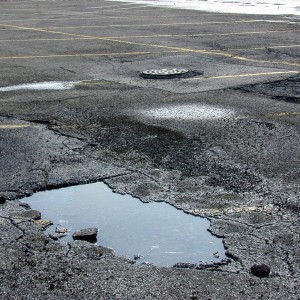Seasonal Parking Lot Repairs
Regardless of your location, parking lot repairs can and should be addressed throughout the winter months to prevent the spread of problem areas and to mitigate potential liabilities. After all, just one slip-and-fall injury could result in costly litigation, increased insurance premiums, and worst of all–a tarnished image.
The following procedures and treatments can be performed on your parking lot this winter. Understanding your options will help you to make better decisions concerning the maintenance of your parking lot during cold-weather months and it will help you budget for long-term parking lot repairs in the spring.
 Patching – Depending on the size, severity, and geographic location, potholes may be patched or the area may be removed and replaced. If your parking lot is located in a mild winter climate and hot-mix asphalt (HMA) is readily available, removal and replacement is the best, long-term solution and it can be completed right away. However, if your parking lot is located in an extreme winter climate where harsh weather conditions and/or the unavailability of HMA are factors, treatment with cold patch can be completed as a temporary repair.
Patching – Depending on the size, severity, and geographic location, potholes may be patched or the area may be removed and replaced. If your parking lot is located in a mild winter climate and hot-mix asphalt (HMA) is readily available, removal and replacement is the best, long-term solution and it can be completed right away. However, if your parking lot is located in an extreme winter climate where harsh weather conditions and/or the unavailability of HMA are factors, treatment with cold patch can be completed as a temporary repair.
Infrared – This solution uses hot-mix asphalt instead of cold patch. Damaged asphalt is heated to 325 degrees for 5 or 10 minutes, raked to remove failed aggregate, and sprayed with a rejuvenator to replenish lost oils due to oxidation. Once the material has been placed, it is compacted by vibratory plates. Learn more about the Infrared repair process here!
Crack sealing – The best time to seal is when cracks measure 1/4-inch to 1-inch wide. Sealing cracks prevents excess moisture from seeping into pavement and softening or weakening the sub-base. If your property is located in a mild climate, avoid the potential risk and seal all cracks in sidewalks and other high-traffic areas immediately.
Sealcoating – Typically a spring or fall procedure, sealcoating can be performed during winter if the climate permits. Recommended air and pavement temperature should be at least 55°F and rising during sealer application and for 8 hours afterward. An additional, seasonal benefit is that sealcoating yields a smooth and even pavement texture, which makes snow removal easier and sweeping more effective.
Snow Removal – If your site experiences snowfall, be sure you have a plan in place to remove it. Based on your unique needs such as site location, climate, and budget, your facility parking lot can be plowed per snowfall occurrence or seasonally (based on an average yearly snowfall depth, pre-determined for that region).
Wintertime Budgeting Tips – If you haven’t already, make time to walk your parking lot and assess the damage caused after a long summer of damaging UV rays and heavy rain. To ensure an accurate pavement evaluation, enlist the help of a reputable parking lot maintenance contractor. He or she can identify and prioritize repairs so that your budget dollars are spent at the right time and in the most effective manner.




